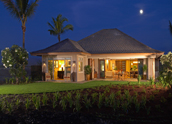ISLAND OF MOLOKAI
County Offices
200 South High Street
Wailuku, Maui 808-270-7838
www.mauicounty.gov
Chamber of Commerce
313 Ano Street
Kahulu, Maui 808-871-7711
www.mauichamber.com
Visitor’s Bureau
1727 Wili Pa Loop
Wailuku, Maui 808-244-3530
www.gohawaii.com/lanai
Often referred to as the “most Hawaiian” or the friendliest of the populated islands, Molokai was once largely a leper colony. Today, this lovely jewel in the Pacific Ocean is known for its breathtaking beauty, contrasting dense rain forests with deserted white-sand beaches. Molokai and Lanai islands are both encompassed within the County of Maui and are the smallest of the Hawaiian island string. The “main street” of Molokai is in Kaunakakai, although the island is lacking in the bustle of commercial development or even contemporary scenes like traffic lights.
What residents of Molokai lack in urban amenities, they are able to enjoy in exquisite natural beauty and tranquility. Some of the most diverse scenery on the islands is showcased on Molokai, including Hawaii’s largest white-sand beach, the twisted trails of Maunaloa and Naiwa, the highest sea cliffs in the world, and one of the largest reef system on the islands. Molokai is truly an intermingling of the history, tradition, and culture of Hawaii.
Services
State-of-the-art healthcare services are anchored on Molokai by Molokai General Hospital, affiliated with the internationally respected Queen’s Medical Center in Honolulu. As the largest private hospital in Hawaii, Queen’s Medical Center is licensed to operate with 505 acute-care beds and nearly 30 sub-acute beds. More than 3,000 employees and 1,200 staff physicians make Queen’s the leading medical referral center in the entire Pacific Basin, providing access to a comprehensive range of primary and specialized care services. The island of Maui offers two more hospitals within the HHSC system: Kula Hospital in Kula and Maui Memorial Medical Center in Wailuku. Constantly growing, upgrading, and expanding to meet changing needs, Maui Memorial employs more than 1000 employees and 200 attending physicians. The latest addition to the complex is the new wing opened in 2007, the four-level Kahului Tower.
First-rate educational experiences are available in the public schools within the Hana-Lahainaluna-Laiai-Molokai Area Complex of the County of Maui. Maui Community College in Kahului serves as a tri-island institution of higher education, providing comprehensive opportunities, special programs, and a bachelor’s degree program at its UH Center on Maui. Molokai is home to one of the education centers for the college, with available programs and coursework enhanced by a pioneering television network that reaches rural areas. The Culinary Arts program and the Maui Language Institute are two of many outstanding offerings. The University of Hawaii provides three major four-year campuses: Two on the island of Oahu in Pearl City and Honolulu and one on Hawaii, the Big Island. Oahu is also home to a number of private colleges that include Argosy University Honolulu, Brigham Young University-Hawaii, Chaminade University, Hawaii Pacific University, Heald College-Honolulu, Remington College, TransPacific Hawaii College, the University of Phoenix, and Wayland Baptist University.
Lifestyle
“The road less traveled” is an appropriate description of the byways that meander across the island of Molokai, home to historic and natural preservation. Papokaku is one of the island’s pristine beaches, distinguished as the largest white-sand beach in the Hawaiian Islands. With three miles of soft-sand beach, Papohaku Beach stretches along Molokai’s western end. Each May, Papohaku Beach Park springs to life as the setting for the colorful Molokai Ka Hula Piko—the island’s most well-attended cultural festival. Campsites, picnic areas, and convenient amenities are graced by the haunting beauty of Oahu views. In fact, Waikiki once took sand from Papohaku to help build up its own shores. The Aloha Music Camp is another popular event, immersing residents and visitors in Hawaiian culture.
At the edge of Kalaupapa Lookout in Palaau State Park, visitors can gaze down nearly 2,000 feet to the peninsula below for a breathtaking realization of Molokai beauty. The island claims the world’s tallest sea cliffs and fascinating historic sites like the phallic-shaped stone known as Kauleonanahoa—one of the island’s finest examples of traditional fertility rock. Other ancient sites reflect the 1865 decision of King Kamehameha V, who selected Molokai as the coffee-growing region for the Kingdom of Hawaii. Today, visitors take mule-drawn tours in the rolling hills of Kualapuu near the center of the island, where the 500-acre plantation of Coffees of Hawaii welcomes them with a fine cup of 100 percent Molokai coffee. Nearby, the Molokai Museum and Cultural Center hosts an extensive collection of artwork from the late 1800s. Restored to its original operating condition, the R.W. Meyer Sugar Mill is a National Historic Place constructed in 1878. Many of the island’s oceanfront bed and breakfast inns dot the drier western end of Molokai, although those who are seeking more rarified views will find charming homes and sprawling resorts tucked away in the hills of Maunaloa near Kaupoa Beach Village. Those who value serenity and simplicity are sure to find the ideal home on Molokai.

